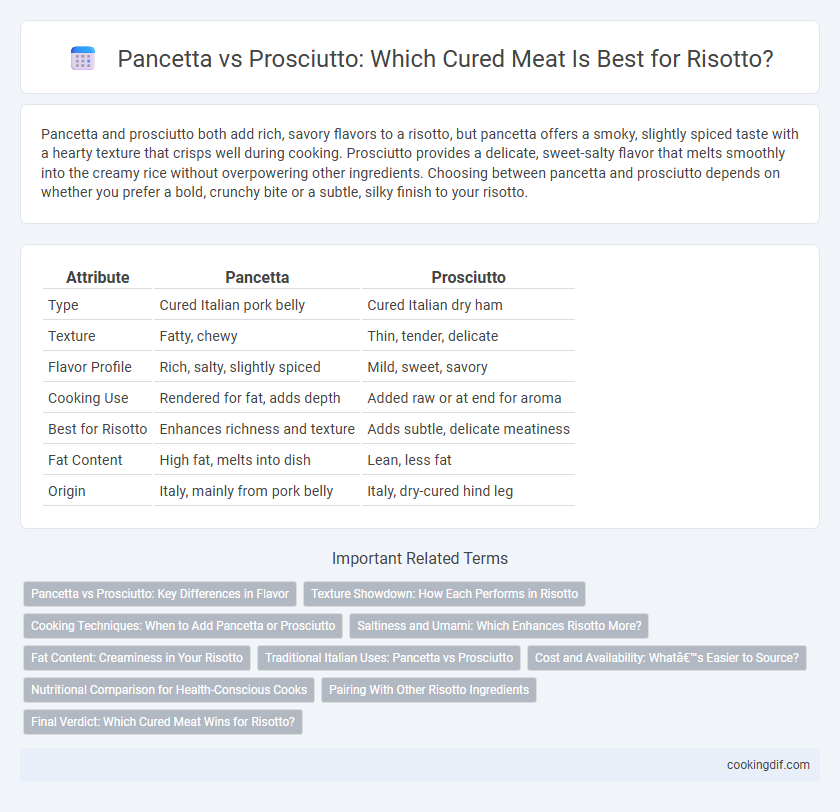Pancetta and prosciutto both add rich, savory flavors to a risotto, but pancetta offers a smoky, slightly spiced taste with a hearty texture that crisps well during cooking. Prosciutto provides a delicate, sweet-salty flavor that melts smoothly into the creamy rice without overpowering other ingredients. Choosing between pancetta and prosciutto depends on whether you prefer a bold, crunchy bite or a subtle, silky finish to your risotto.
Table of Comparison
| Attribute | Pancetta | Prosciutto |
|---|---|---|
| Type | Cured Italian pork belly | Cured Italian dry ham |
| Texture | Fatty, chewy | Thin, tender, delicate |
| Flavor Profile | Rich, salty, slightly spiced | Mild, sweet, savory |
| Cooking Use | Rendered for fat, adds depth | Added raw or at end for aroma |
| Best for Risotto | Enhances richness and texture | Adds subtle, delicate meatiness |
| Fat Content | High fat, melts into dish | Lean, less fat |
| Origin | Italy, mainly from pork belly | Italy, dry-cured hind leg |
Pancetta vs Prosciutto: Key Differences in Flavor
Pancetta delivers a rich, salty flavor with a slightly fatty and savory profile that intensifies as it crisps during cooking, making it ideal for infusing risotto with depth and texture. Prosciutto offers a delicate, sweet, and subtly nutty taste with a tender, silky texture that adds a refined, aromatic quality to the dish when stirred in at the end. The choice between pancetta and prosciutto significantly influences the risotto's flavor complexity and mouthfeel, with pancetta providing a robust, hearty essence and prosciutto lending a lighter, more elegant touch.
Texture Showdown: How Each Performs in Risotto
Pancetta delivers a rich, chewy texture that crisps up beautifully in risotto, providing a savory bite that contrasts with the creamy rice. Prosciutto, being thinner and drier, melts gently into the risotto, lending a silky, delicate mouthfeel without overpowering the dish's softness. Choosing pancetta intensifies texture and flavor depth, while prosciutto enhances subtlety and smoothness in every spoonful.
Cooking Techniques: When to Add Pancetta or Prosciutto
Pancetta is best added early in the cooking process to render its fat and infuse the risotto with a rich, savory base, typically sauteed with onions or garlic before adding rice. Prosciutto, being thinner and drier, is usually stirred in towards the end or used as a garnish to preserve its delicate texture and distinct flavor. Adjusting the timing of these cured meats ensures optimal flavor release and textural contrast in the final risotto dish.
Saltiness and Umami: Which Enhances Risotto More?
Pancetta offers a balanced saltiness and rich umami that melts into risotto, enhancing its creamy texture and deepening flavor complexity. Prosciutto, with its intense saltiness and pronounced savory notes, provides a sharper contrast but can overpower the delicate rice if used excessively. For a harmonious risotto, pancetta's mild umami and subtle saltiness create a more integrated and satisfying taste experience.
Fat Content: Creaminess in Your Risotto
Pancetta contains a higher fat content than prosciutto, contributing significantly to the creamy texture of risotto by melting into the rice during cooking. Prosciutto, with its leaner profile, adds a subtle savory flavor but less richness and silkiness compared to pancetta. Choosing pancetta enhances the risotto's mouthfeel and depth, creating a more indulgent and luscious dish.
Traditional Italian Uses: Pancetta vs Prosciutto
Pancetta is traditionally used in Italian risotto for its rich, fatty texture and robust, salty flavor that renders well when sauteed, adding depth to the dish. Prosciutto, while also a cured meat, is typically added thinly sliced at the end or used as a garnish to preserve its delicate, slightly sweet taste and tender texture. Authentic Italian recipes favor pancetta for cooking within the risotto versus prosciutto's role as a finishing touch or complementary ingredient.
Cost and Availability: What’s Easier to Source?
Pancetta is generally more affordable and widely available in grocery stores and supermarkets compared to prosciutto, making it a budget-friendly option for risotto. Prosciutto, often sold in thin, delicate slices, tends to be pricier due to its longer curing process and premium quality. For home cooks seeking convenience and cost-effectiveness, pancetta is easier to source and incorporate into creamy risotto dishes.
Nutritional Comparison for Health-Conscious Cooks
Pancetta and prosciutto differ significantly in their nutritional profiles, with pancetta typically containing higher fat and calorie content due to its fatty cut, making it richer but more energy-dense. Prosciutto offers a leaner option, lower in calories and saturated fats, which suits health-conscious cooks aiming to reduce fat intake without sacrificing flavor. Both provide protein and essential minerals, but prosciutto's lower sodium levels may benefit those monitoring salt consumption in their risotto recipes.
Pairing With Other Risotto Ingredients
Pancetta offers a rich, fatty flavor that enhances risotto dishes by complementing hearty ingredients like mushrooms and Parmesan, creating a savory depth. Prosciutto, with its delicate, salty profile, pairs well with lighter risotto components such as peas, asparagus, and lemon zest, adding a subtle complexity. Both cured meats elevate risotto by balancing creaminess and texture, but choosing between pancetta and prosciutto depends on the desired flavor intensity and ingredient harmony.
Final Verdict: Which Cured Meat Wins for Risotto?
Pancetta offers a rich, fatty flavor that melts perfectly into risotto, enhancing its creamy texture with savory depth. Prosciutto provides a delicate, slightly sweet profile that adds a refined, salty contrast without overpowering the dish. For a traditional risotto balance, pancetta is the preferred cured meat, delivering a robust umami boost that complements the creaminess better than prosciutto.
Pancetta vs Prosciutto for cured meat addition Infographic

 cookingdif.com
cookingdif.com